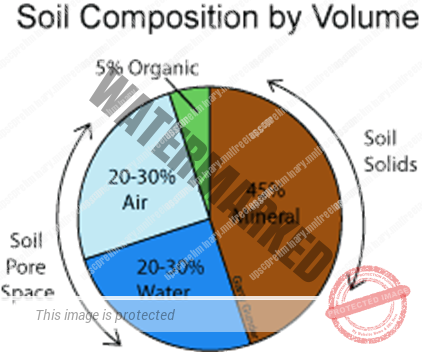- SOIL COMPOSITION
- SOIL CHARACTERISTICS
- SOME STRUCTURAL CHARACTERISTICS OF SOIL
UNIT 5 – SOIL – PART 1
SOILS
Soil is the thin top layer on the earth’s crust comprising rock particles mixed with organic matter. Pedology is the study of soils in their natural environment. Pedogenesis is the natural process of soil formation that includes a variety of processes such as Weathering, Leaching, Calcification etc. The Soil formation is mainly related to the parent rock material, surface relief, climate, and natural vegetation.
SOIL COMPOSITION
Soils have four main constituents:
- MINERAL MATTER – It includes all minerals inherited from the parent material as well as those formed by recombination from substances in the soil solution.
- ORGANIC MATTER – It is derived mostly from decaying plant material broken down and decomposed by the actions of animals and microorganisms living in the soil. (Note: The end product of breakdown of dead organic material is called humus.)
- AIR
- WATER
Normally, both air and water fill the voids in soil. Air and water in the soil have a reciprocal relationship since both compete for the same pore spaces.
For example, after a rain or if the soil is poorly drained, the pores are filled with water and air is excluded. Conversely, as water moves out of a moist soil, the pore space is filled with air. Thus, the relationship between air and water in soils is continually changing.
The ratio of the components by volume is generically indicated as:
SOIL CHARACTERISTICS:
Knowing a soil’s water, mineral, and organic components and their proportions can help us determine its productivity. Some of the important characteristics are:
- COLOR
A soil’s colour is generally related to its physical and chemical characteristics.
Black Soils rich in humus tend to be dark because decomposed organic matter is black or brown. Soils with high humus content are usually very fertile, so dark brown or black soils are often referred to as ‘rich’. [Note – Some dark soils may be dark because of other soil forming factors and may have little or no humus]
Red or yellow soils typically indicate the presence of iron.
- TEXTURE
The soil texture refers to the Coarseness/Fineness the mineral matter in the soil. It is determined by the proportion of the sand, silt and clay particles:
Clay: Particle Size – diameters less than 0.002 millimeters
Silt: Particle Size – diameters between 0.002 millimeters to 0.05 millimeters.
Sand: Particle Size – diameters between 0.05 and 2 millimeters.
[Rocks larger than 2 millimeters are regarded as pebbles, gravel, or rock fragments and technically are not soil particles.]
The soil texture directly affects:
- The soil water content
- Water flow
- Retention of nutrients
- Extent of aeration
Note: Generally speaking, Good Soils = Clay + Humus. The clay-humus complex is essential for a fertile soil as it provides it with a high water and nutrient holding capacity. Humus acts as cement binding the soil particles together and thus reducing the risk of erosion.
STRUCTURE
While the soil texture describes the size of soil particles, soil structure refers to the arrangement of the soil particles. The way in which sand, silt, clay and humus bond together is called soil structure.
SOME STRUCTURAL CHARACTERISTICS OF SOIL
- PERMEABILITY – The ease with which liquids/gases can pass through rocks or a layer of soil is called permeability. It depends on the size, shape and packing of particles. It is usually greatest in sandy soils and poor in clayey soils.
- POROSITY – The volume of water which can be held within a soil is called its porosity. It is expressed as a ratio of volume of voids (pores) to the total volume of the material.
SOIL CHEMISTRY – ACIDITY OR ALKALINITY
An important aspect of soil chemistry is Acidity, Alkalinity (baseness), or Neutrality.
Low pH values indicate an acidic soil.
High pH indicates alkaline conditions.
- In Arid and Semi-Arid regions, soils tend to be alkaline and soils in humid regions tend to be acidic.
- To correct soil alkalinity and to make the soil more productive, the soil can be flushed with irrigation water.
- Strongly acidic soils are also detrimental to plant growth, but soil acidity can generally be corrected by adding lime to the soil.

